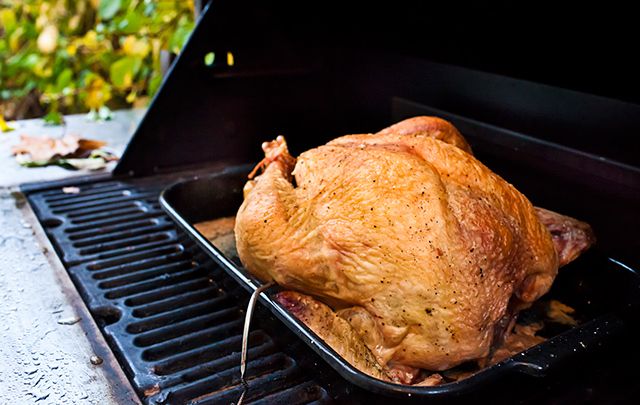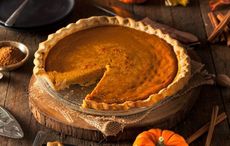Save some precious kitchen space by cooking your Thanksgiving turkey on the barbecue!
Cooking a Thanksgiving dinner, with its multitude of scrumptious trimmings, for a hungry gaggle of family and guests is quite a challenge, especially when the cook has to make do with rather limited cooking resources.
However, a golden opportunity presents itself for those lucky enough to possess a covered barbecue – be it charcoal or gas-fired – for the cook of the day to earn lots of brownie points, and the unfortunate person who drew the short straw to clean the fat-splattered, ex-turkey oven, a welcome respite.
Benefits of barbecuing your Thanksgiving turkey:
1. Valuable oven space is freed up for other culinary duties.
2. The succulence, terrific taste, beauty to the eye of the beholder and the bewitching aroma that pervades the atmosphere transcends, in my humble opinion, the impact that oven-cooked birds usually produce AND, if the turkey is smoke-cooked, the resultant golden mahogany veneer will be the propellant responsible for projecting the taste buds of all those nearby into mouth-watering overdrive!
3. The oven (see above) retains its original pristine state (which is nice!)
4. After the cook has retrieved the bird, perhaps braving the elements*, and presented it for approval to the hungry throng he or she can bask in some well-deserved back-slapping hero-worshiping (always good for a barbecue chef's ego).
*Neither rain nor snow should prevent you from using your barbecue but a cold wind whistling around the cooking area will require an extended cooking period which should be factored into your timetable.
Prepping your Thanksgiving turkey for the barbecue:
Prepare your barbecue for 'indirect cooking'
Ensure the giblets and neck have been removed from the bird's cavity. Rinse the turkey all over with cold water and inside its neck and body cavities. Pat dry with kitchen toweling. Sprinkle the cavities generously with salt and freshly ground pepper.
Tuck the wings behind the bird's back but leave the legs free i.e. not tucked into the band of skin by the parson's nose (the tail end) or tied closely together.
Use your clean hand, or a small brush, to spread groundnut oil or softened butter (margarine if you prefer) all over the bird. Lightly season the oiled surfaces with salt and freshly ground black pepper.
Carefully position the turkey on its back down the center of the grill, partially shielding the sides where it touches the grill bars with a double band of foil about 4” wide. Tuck one edge of the band under the bird's back to help secure it. Wrap a 2 to 3-inch wide band around each knuckle and the lower part of the legs. Position a meat thermometer deep inside the fattest muscle section of a leg. Make sure that the tip of the thermometer does not touch the bone – it will give a false reading if it does.
Cooking your Thanksgiving turkey on the barbecue:
Cook the turkey, with the lid of the barbecue down, until the thermometer registers 185 F/100C.
For charcoal units, apart from the weather conditions mentioned above, this will vary according to the quality and burning characteristics of the fuel you are using. For example, replenishing the fire-bed partway through cooking, with fresh briquettes, will result in a marked drop in temperature. The resulting extension of the cooking period should, therefore, be factored in. Fortunately, there are charcoal briquettes on the market with a burn duration that hopefully will enable you to tackle a large bird or joint without recourse to mid-flight refueling.
As a rough guide to cooking times (cooking at medium heat), somewhere in the region of 2 ½ hours for an 11 – 13 lb turkey whereas a 20 - 22 lb bird will cook faster per lb thus only requiring about 3 ½ - 4 hours to be fully cooked. Allow 20 – 30 minutes additional cooking time if the bird is fully stuffed* at the neck. *To make extra stuffing (there never seems to be enough!) bake some separately in a small oven-proof dish. Place the dish, or dishes, fore and/or aft of the bird (not directly over the fire bed) during the final 30-40 minutes of cooking. Leave the dishes on the covered barbecue (on low heat) whilst the turkey is settling down before being carved.
Tip: Roughly halfway through roasting the bird, turn it 180 degrees to help avoid uneven cooking.
Immediately after removing the magnificent bird from the barbecue, flaunt it (this should get the digestive juices up and running big time) before letting it rest for 20 minutes or so prior to carving.
Bonus! Hickory-smoked turkey with a rich Irish glaze recipe:
A sure-fire way to make your turkey look even more stunning, even tastier is to smoke-cook it.
Simply add 2–3 chunks, or 2–3 handfuls of small chips of hickory wood* to the barbecue's fire-bed (be it charcoal or gas) roughly halfway through the prescribed cooking period. Add the wood earlier if you wish to deepen the bird's color and increase its piquancy.
During the final 15 minutes or so of cooking brush the bird all over with a glaze made by beforehand by mixing roughly 2 oz of softened butter with 2-3 tablespoons of Irish Malt Whiskey. Alternatively, you could use your favorite liqueur ... Drambuie perhaps.
Soaking the wood in water or beer beforehand will prolong its use. However 'un-wetted chunks (not chips) normally have sufficient life in them, after they have done their job, to carry out further smoking.
For more tips from Jim check out his book “The Barbecue Book" and "Tips for Your Barbecue" with Ebury Publishing.
*Originally published in 2011. Updated in Nov 2024.




Comments